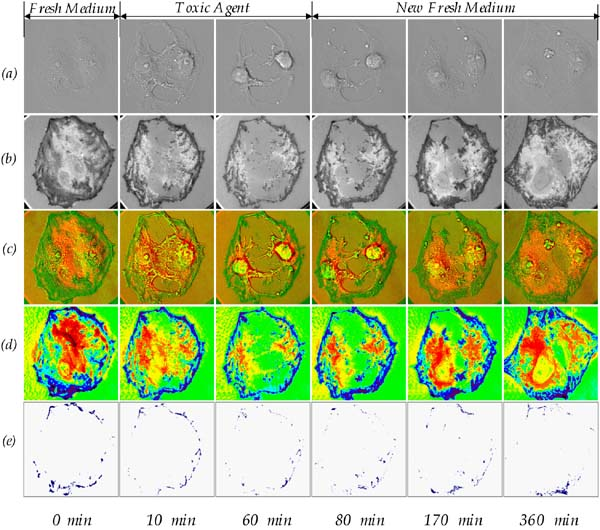Opto-electric cellular sensing

Analysis of DICM and IRCM images. (a) DICM images just before the addition of Cytochalasin D, 10 minutes and 1 hour after replacement with cytotoxic medium, and approximately 20 mins, 2 hours, and 5 hours after replacement with fresh medium. (b) The corresponding IRCM images. (c) Pseudo-color IRCM-DICM overlay images using green for IRCM images and red for DICM images. (d) The corresponding contours were created by separating pixels into bins of 1000 PGLs. (e) PGLs below 6500 were set to black on the IRCM images. The overlay images (c) and the corresponding contours provide qualitative information regarding ventral morphological changes in PPAECs under toxic and normal conditions. In order to prevent cell damage that can be caused by high-intensity illumination, both the Halogen and Xenon lamps were shuttered when images were not being taken. The field-of-view size of all images is 80 micron x 80 micron.
Multi-contrast microscopy techniques were used to comprehensively and dynamically map the cellular contact area adhering to a substrate. The natural fringe patterns observed with interference reflection contrast microscopy were used to map the dynamic fingerprint of a porcine pulmonary artery endothelial cell¡¯s ventral surface and to examine the focal and/or close contacts to the substrate, when exposed to a toxic agent Cytochalasin D. In addition, differential interference contrast microscopy sequentially imaged the entire cells morphological responses to the agent. It was observed that focal contacts, which are tightly attached to the substrate, are strongly resistant to even high doses of the cytotoxic agent and that they also form the basis of cellular recovery after replacement of the cytotoxic medium with fresh complete medium.
*This work was originally done as one of Dr. Choi's graduate works under Dr. Kihm's suervision and he is very interested in working on the further development of "opto-electric sensors" to detect single cell by using optically transparent and electrically conductive indium tin oxide electrodes.
C. K. Choi, C. H. Margraves, K. D. Kihm, and A.E. English, Dynamic Fingerprinting of
Cellular Focal Contacts under Cytotoxic Conditions Using Quantitative Analysis
of Natural Fringes, Journal
of Biomedical Optics, Vol. 13, Issue 5, 054069, 2008

